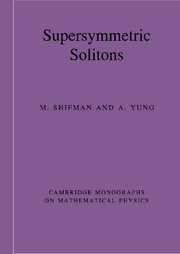Book contents
- Frontmatter
- Contents
- Acknowledgments
- List of abbreviations
- 1 Introduction
- I SHORT EXCURSION
- II LONG JOURNEY
- Introduction to Part II
- 4 Non-Abelian strings
- 5 Less supersymmetry
- 6 Non-BPS non-Abelian strings
- 7 Strings on the Higgs branches
- 8 Domain walls as D-brane prototypes
- 9 Wall-string junctions
- 10 Conclusions
- Appendix A Conventions and notation
- Appendix B Many faces of two-dimensional supersymmetric CP(N – 1) model
- Appendix C Strings in N = 2 SQED
- References
- Index
- Author index
Introduction to Part II
from II - LONG JOURNEY
Published online by Cambridge University Press: 28 July 2009
- Frontmatter
- Contents
- Acknowledgments
- List of abbreviations
- 1 Introduction
- I SHORT EXCURSION
- II LONG JOURNEY
- Introduction to Part II
- 4 Non-Abelian strings
- 5 Less supersymmetry
- 6 Non-BPS non-Abelian strings
- 7 Strings on the Higgs branches
- 8 Domain walls as D-brane prototypes
- 9 Wall-string junctions
- 10 Conclusions
- Appendix A Conventions and notation
- Appendix B Many faces of two-dimensional supersymmetric CP(N – 1) model
- Appendix C Strings in N = 2 SQED
- References
- Index
- Author index
Summary
Ever since 't Hooft [124] and Mandelstam [125] put forward the hypothesis of the dual Meissner effect to explain color confinement in non-Abelian gauge theories, people were trying to find a controllable approximation in which one could reliably demonstrate the occurrence of the dual Meissner effect in these theories. A breakthrough achievement was the Seiberg–Witten solution [2] of N = 2 supersymmetric Yang–Mills theory. They found massless monopoles and, adding a small (N = 2)-breaking deformation, proved that they condense creating strings carrying a chromoelectric flux. It was a great success in qualitative understanding of color confinement.
A more careful examination shows, however, that details of the Seiberg–Witten confinement are quite different from those we expect in QCD-like theories. Indeed, a crucial aspect of Ref. [2] is that the SU(N) gauge symmetry is first broken, at a high scale, down to U(1)N-1, which is then completely broken at a much lower scale where condensation of magnetic monopoles occurs. Correspondingly, the strings in the Seiberg–Witten solution are, in fact, Abelian strings [36] of the Abrikosov–Nielsen–Olesen (ANO) type which results, in turn, in confinement whose structure does not resemble at all that of QCD. In particular, the “hadronic” spectrum is much richer than that in QCD [126, 127, 128, 35, 129].
- Type
- Chapter
- Information
- Supersymmetric Solitons , pp. 81 - 84Publisher: Cambridge University PressPrint publication year: 2009



